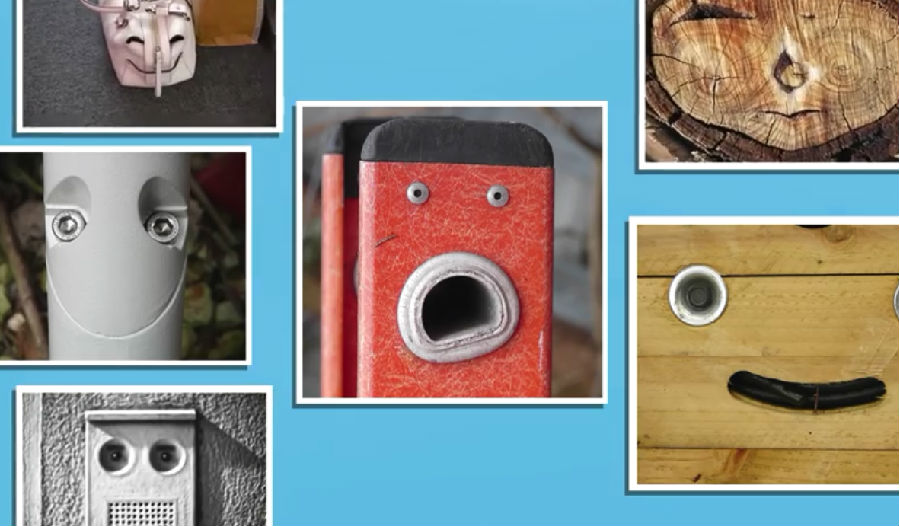When you look at a picture like this, what do you see? Chances are you see a face.
从这张图片上大家看到了什么?答案可能是一张脸。
You see eyes, you see a mouth, you see emotions, even though these are just inanimate objects, there's nothing there.
有眼睛,有嘴巴,有表情,虽然这些都只是没有生命的东西,那里根本就没有什么脸。
But you've heard this story before, the internet loves pictures like these.
这其实已经不奇怪了,因为网上这类图片多得是。
They sell on eBay for a lot of money, and they make headlines all the time.
有人靠这些表情在eBay上赚了很多钱,这些表情还总是会登上头条。
"They say it's the face of Jesus etched by nature on a hillside, look at this."
“有人说这是自然在某山坡上冲刷出来的上帝之脸,大家请看。”
"I certainly feel blessed." "Jesus."
“我的确觉得很幸福。”“上帝”
It's clearly the image of what we know to be Jesus, and there must be a reason.
这画上的显然就是上帝,它出现在这里肯定是有原因的。
" It's caused by this phenomenon called pareidolia, which is Greek for "beyond the image."
“这种现象就是所谓的‘空想性错视’,希腊语里的意思是‘图像之外’。”
Way back in the day it was considered a symptom of psychosis,
很久以前,这种感觉被视为精神病的病症,
Leonardo da Vinci wrote about it in a notebook as good inspiration for painters,
达芬奇则在笔记中称这种感觉是画家灵感的重要源泉,
and psychologists started to use it as a mental evaluation technique.
之后,心理学家才开始将其作为一种精神分析工具。
The idea behind it is that our brains consume a lot of random information all the time
背后的逻辑就是我们的大脑一直会接收很多随机的信息,
and they're constantly trying to pinpoint patterns to make sense of everything around us.
试图总结出一些规律,从而帮助我们感知周围的世界。
So when we look at something like concrete floor,
所以,当我们看到地板这种东西时,

our brains pick up the stuff that makes sense like a letter of the alphabet or two eyes and nose.
我们的大脑就会寻找地板上像字幕或者两个眼睛一个鼻子这种有意义的图案。
And these are the things that we're most comfortable with and familiar with,
因为这些东西是我们最熟悉又最让我们感觉舒服的东西。
so whether or not they're actually there, they're what we tend to perceive because they make sense to us.
所以,不管它们是否真的存在,我们都有看到它们的倾向,因为它们是有意义的。
In this one experiment from 2011, people were shown faces hidden inside a noise background and they recognized them really well,
在2011年一项试验中,受试者能够很好地识别出位于混杂图案背景中的面部图案,
over 90 percent of the time in each trial.
每次试验成功率都高达90%以上。
But when they were given noise-only images without faces hidden in them,
然而,当他们看到只有噪声没有隐藏在其间的面部图案时,
participants kept seeing faces about 40 percent of the time, even when there was nothing there.
仍有40%的受试者能看到面部图案,尽管这些图案事实上根本就不存在。
Now scientists believe that this response is caused by a specific part of the brain called the Fusiform face area which is specialized for facial recognition.
科学家认为,这种反应是由大脑中控制面孔识别的的梭状回引起的。
And it starts working really early in humans.
该组织在人体发育早期就已开始工作。
Studies have shown that babies who were given drawings that look like this
研究发现,宝宝在拿到这样的图画时,
will consistently gravitate towards the one that's arranged to look like a human head by about 12 months old.
始终会将其作为一个人的头部来理解,这种认知一直会持续到他周岁大。
"On the tortilla takes on the appearance on Jesus his head his facial hair the whole thing."
"这张玉米薄饼上出现了上帝耶稣的图像,他的头,他的胡子,什么都有。"
But here's where it gets interesting.
然而,有趣的地方在这里。
In a 2013 study, researchers at the University of Helsinki tested 47 people for pareidolia.
在2013年的一项研究中,来自赫尔辛基大学的研究员针对47名受试者进行了‘空想性错视’ 试验。
Some of them were religious or paranormal believers, and some of them were not.
这些受试者有些信仰宗教或超自然,有些则不是。
And they found that the believers were consistently more prone to perceiving faces in random patterns than the skeptics were.
研究者发现,那些有信仰的人更容易从随机图案中看到脸的图案。
So really it's no surprise that so many of these incidents involve seeing a face of a religious figure in a random pattern and that's what makes this so interesting.
所以,虽然有那么多从随机图案中看出宗教人物的实例很多,却也不足为奇,这也正是这件事有趣的地方。
Our constant search for meaning in everything is actually hardwired in our brains.
我们不断地追寻各种事物的意义,结果不过是我们的大脑在作祟。
And that's what makes us who we are.
也正是这种看待事物的方式决定了我们是什么样的人。


